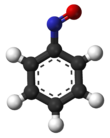- Nitrosobenzene
-
Nitrosobenzene 
 NitrosobenzeneOther names?
NitrosobenzeneOther names?Identifiers CAS number 586-96-9 
PubChem 11473 ChemSpider 10989 
KEGG C06876 
ChEBI CHEBI:27986 
ChEMBL CHEMBL98797 
RTECS number DA6497525 Jmol-3D images Image 1 - O=Nc1ccccc1
Properties Molecular formula C6H5NO Molar mass 107.11 g/mol Appearance colourless solid Density ? g/cm3, ? Melting point 65-69 °C
Boiling point 59 °C, 18 mm Hg
Solubility in water low Solubility in other solvents sol. in organic solvents Structure Molecular shape N is sp2 Hazards R-phrases 20/21-25 S-phrases 26-36/37-45 Main hazards toxic Related compounds Related compounds Nitrobenzene
Aniline (verify) (what is:
(verify) (what is:  /
/ ?)
?)
Except where noted otherwise, data are given for materials in their standard state (at 25 °C, 100 kPa)Infobox references Nitrosobenzene is the organic compound with the formula C6H5NO. The compound can be viewed as hybrid of singlet O2 and azobenzene. This diamagnetic species exists in equilibrium with its dimer.
Contents
Preparation
C6H5NO was first prepared by Adolf von Baeyer by the reaction of diphenylmercury and nitrosyl bromide:[1]
-
- [C6H5]2Hg + BrNO → C6H5NO + C6H5HgBr
The modern synthesis entails reduction of nitrobenzene to phenylhydroxylamine, C6H5NHOH, which is then oxidized by Na2Cr2O7.[2] C6H5NO can also be prepared by oxidation of aniline using peroxymonosulfuric acid, Caro's acid.[3] It is usually purified by steam distillation, where it comes over as a green liquid that solidifes to a colorless solid.
Characteristic reactions
The monomer undergoes Diels-Alder reactions with dienes.[4] Condensation with anilines affords azobenzene derivatives (Mills reaction)[5]. Reduction of PhNO produces C6H5NH2.
Most characteristically nitrosobenzene condenses with "active" methylene groups, e.g. of malonic esters, benzyl cyanide etc. For example, condensation with benzylcyanide PhCH2CN gives the imine PhC(CN)=NPh (The Ehrlich-Sachs Reaction)[6] :
Ph-CH2-CN + Ph-NO → Ph-CH(CN)-N(OH)-Ph (oxyamination adduct) → PhC(CN)=N(OH)Ph
Sometimes condensation with "active" methylene compounds could give products of O-nitroso-aldol reaction [7]:
R-CH2-CHO + Ph-NO → R-CH(CHO)-O-NHPh (aminoxylation adduct)
See also
References
- ^ Baeyer, A. "Nitrosobenzol und Nitrosonaphtalin" Chemische Berichte 1874, volume 7, pp.1638–1640.
- ^ G. H. Coleman, C. M. McCloskey, F. A. Stuart (1955), "Nitrosobenzene", Org. Synth., http://www.orgsyn.org/orgsyn/orgsyn/prepContent.asp?prep=CV3P0668; Coll. Vol. 3: 668
- ^ H. Caro, Z. angew. Chem., volume 11, p 845ff (1898).
- ^ H. Yamamoto, N. Momiyama "Rich Chemistry of Nitroso Compounds" Chemical Communications 2005, pp.3514–3525.
- ^ H. D. Anspon (1955), "p-Phenylazobenzoic Acid", Org. Synth., http://www.orgsyn.org/orgsyn/orgsyn/prepContent.asp?prep=CV3P0711; Coll. Vol. 3: 711
- ^ H. Feuer in S. Patai (ed.) "The Chemistry of the Nitro and Nitroso Groups Part 1," Wiley: New York. pp. 278-283
- ^ Asymmetric O- and N- Nitroso Aldol Reaction - an efficient access to a-oxy and a-amino carbonyl compound
Categories:- Aromatic compounds
- Nitroso compounds
Wikimedia Foundation. 2010.
